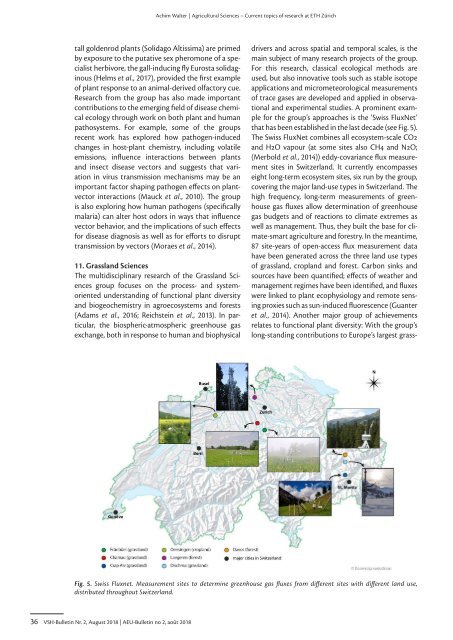12242_VSH_Bulletin_August_2018-3
You also want an ePaper? Increase the reach of your titles
YUMPU automatically turns print PDFs into web optimized ePapers that Google loves.
Achim Walter | Agricultural Sciences – Current topics of research at ETH Zürich<br />
tall goldenrod plants (Solidago Altissima) are primed<br />
by exposure to the putative sex pheromone of a specialist<br />
herbivore, the gall-inducing fly Eurosta solidaginous<br />
(Helms et al., 2017), provided the first example<br />
of plant response to an animal-derived olfactory cue.<br />
Research from the group has also made important<br />
contributions to the emerging field of disease chemical<br />
ecology through work on both plant and human<br />
pathosystems. For example, some of the groups<br />
recent work has explored how pathogen-induced<br />
changes in host-plant chemistry, including volatile<br />
emissions, influence interactions between plants<br />
and insect disease vectors and suggests that variation<br />
in virus transmission mechanisms may be an<br />
important factor shaping pathogen effects on plantvector<br />
interactions (Mauck et al., 2010). The group<br />
is also exploring how human pathogens (specifically<br />
malaria) can alter host odors in ways that influence<br />
vector behavior, and the implications of such effects<br />
for disease diagnosis as well as for efforts to disrupt<br />
transmission by vectors (Moraes et al., 2014).<br />
11. Grassland Sciences<br />
The multidisciplinary research of the Grassland Sciences<br />
group focuses on the process- and systemoriented<br />
understanding of functional plant diversity<br />
and biogeochemistry in agroecosystems and forests<br />
(Adams et al., 2016; Reichstein et al., 2013). In particular,<br />
the biospheric-atmospheric greenhouse gas<br />
exchange, both in response to human and biophysical<br />
drivers and across spatial and temporal scales, is the<br />
main subject of many research projects of the group.<br />
For this research, classical ecological methods are<br />
used, but also innovative tools such as stable isotope<br />
applications and micrometeorological measurements<br />
of trace gases are developed and applied in observational<br />
and experimental studies. A prominent example<br />
for the group’s approaches is the ‘Swiss FluxNet’<br />
that has been established in the last decade (see Fig. 5).<br />
The Swiss FluxNet combines all ecosystem-scale CO2<br />
and H2O vapour (at some sites also CH4 and N2O;<br />
(Merbold et al., 2014)) eddy-covariance flux measurement<br />
sites in Switzerland. It currently encompasses<br />
eight long-term ecosystem sites, six run by the group,<br />
covering the major land-use types in Switzerland. The<br />
high frequency, long-term measurements of greenhouse<br />
gas fluxes allow determination of greenhouse<br />
gas budgets and of reactions to climate extremes as<br />
well as management. Thus, they built the base for climate-smart<br />
agriculture and forestry. In the meantime,<br />
87 site-years of open-access flux measurement data<br />
have been generated across the three land use types<br />
of grassland, cropland and forest. Carbon sinks and<br />
sources have been quantified; effects of weather and<br />
management regimes have been identified, and fluxes<br />
were linked to plant ecophysiology and remote sensing<br />
proxies such as sun-induced fluorescence (Guanter<br />
et al., 2014). Another major group of achievements<br />
relates to functional plant diversity: With the group’s<br />
long-standing contributions to Europe’s largest grass-<br />
Fig. 5. Swiss Fluxnet. Measurement sites to determine greenhouse gas fluxes from different sites with different land use,<br />
distributed throughout Switzerland.<br />
36 <strong>VSH</strong>-<strong>Bulletin</strong> Nr. 2, <strong>August</strong> <strong>2018</strong> | AEU-<strong>Bulletin</strong> no 2, août <strong>2018</strong>


